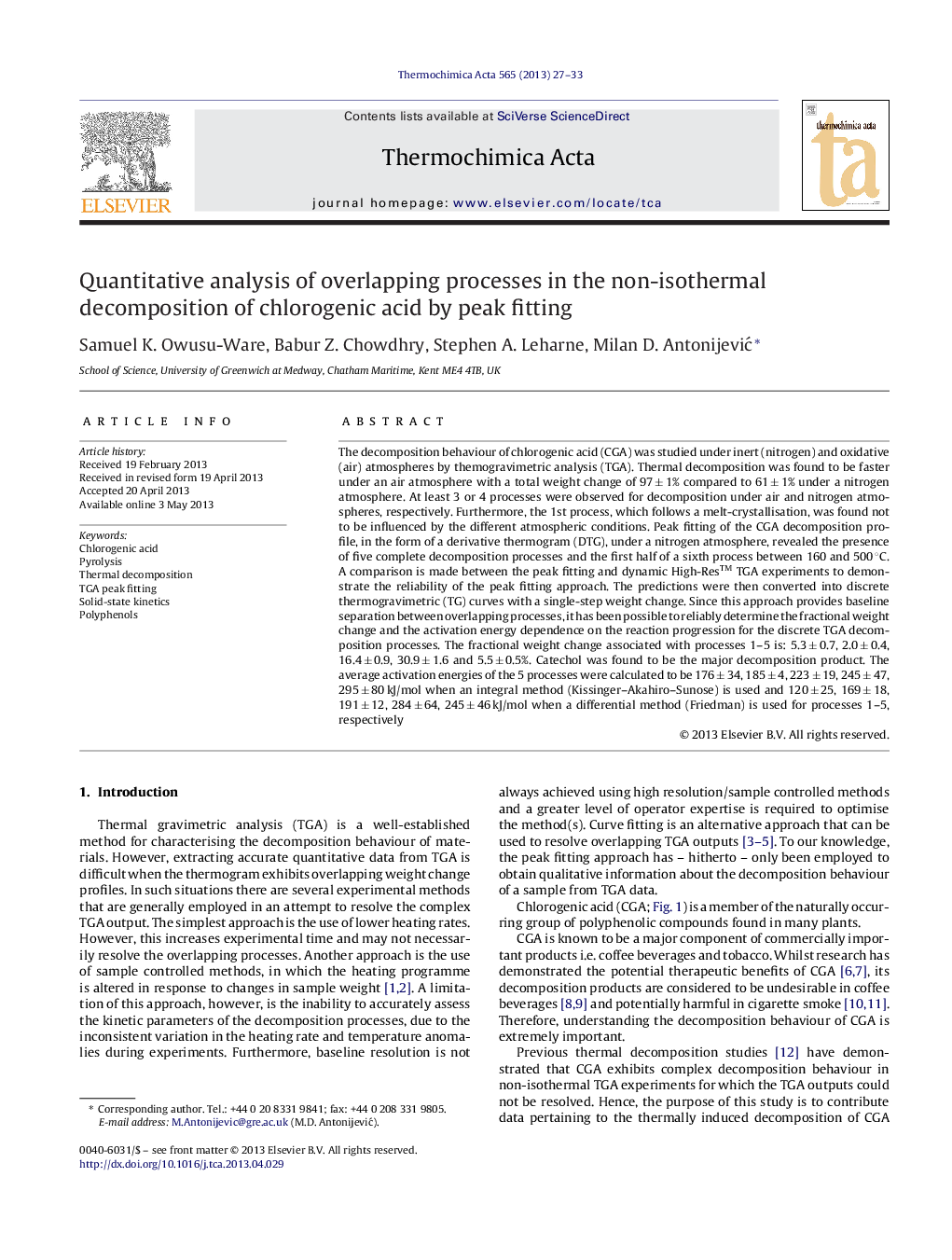| کد مقاله | کد نشریه | سال انتشار | مقاله انگلیسی | نسخه تمام متن |
|---|---|---|---|---|
| 7062410 | 1459519 | 2013 | 7 صفحه PDF | دانلود رایگان |
عنوان انگلیسی مقاله ISI
Quantitative analysis of overlapping processes in the non-isothermal decomposition of chlorogenic acid by peak fitting
ترجمه فارسی عنوان
تجزیه و تحلیل کمی از فرآیندهای همپوشانی در تجزیه غیر ایزوترمال اسید کلرورنیک به واسطه ی اوج اتصالات
دانلود مقاله + سفارش ترجمه
دانلود مقاله ISI انگلیسی
رایگان برای ایرانیان
کلمات کلیدی
موضوعات مرتبط
مهندسی و علوم پایه
مهندسی شیمی
جریان سیال و فرایندهای انتقال
چکیده انگلیسی
The decomposition behaviour of chlorogenic acid (CGA) was studied under inert (nitrogen) and oxidative (air) atmospheres by themogravimetric analysis (TGA). Thermal decomposition was found to be faster under an air atmosphere with a total weight change of 97 ± 1% compared to 61 ± 1% under a nitrogen atmosphere. At least 3 or 4 processes were observed for decomposition under air and nitrogen atmospheres, respectively. Furthermore, the 1st process, which follows a melt-crystallisation, was found not to be influenced by the different atmospheric conditions. Peak fitting of the CGA decomposition profile, in the form of a derivative thermogram (DTG), under a nitrogen atmosphere, revealed the presence of five complete decomposition processes and the first half of a sixth process between 160 and 500 °C. A comparison is made between the peak fitting and dynamic High-Res⢠TGA experiments to demonstrate the reliability of the peak fitting approach. The predictions were then converted into discrete thermogravimetric (TG) curves with a single-step weight change. Since this approach provides baseline separation between overlapping processes, it has been possible to reliably determine the fractional weight change and the activation energy dependence on the reaction progression for the discrete TGA decomposition processes. The fractional weight change associated with processes 1-5 is: 5.3 ± 0.7, 2.0 ± 0.4, 16.4 ± 0.9, 30.9 ± 1.6 and 5.5 ± 0.5%. Catechol was found to be the major decomposition product. The average activation energies of the 5 processes were calculated to be 176 ± 34, 185 ± 4, 223 ± 19, 245 ± 47, 295 ± 80 kJ/mol when an integral method (Kissinger-Akahiro-Sunose) is used and 120 ± 25, 169 ± 18, 191 ± 12, 284 ± 64, 245 ± 46 kJ/mol when a differential method (Friedman) is used for processes 1-5, respectively
ناشر
Database: Elsevier - ScienceDirect (ساینس دایرکت)
Journal: Thermochimica Acta - Volume 565, 10 August 2013, Pages 27-33
Journal: Thermochimica Acta - Volume 565, 10 August 2013, Pages 27-33
نویسندگان
Samuel K. Owusu-Ware, Babur Z. Chowdhry, Stephen A. Leharne, Milan D. AntonijeviÄ,
